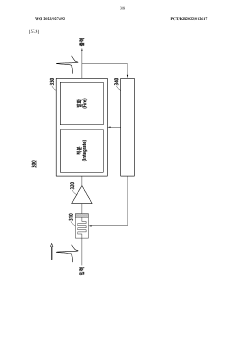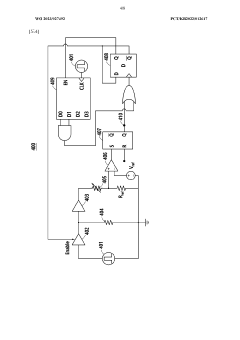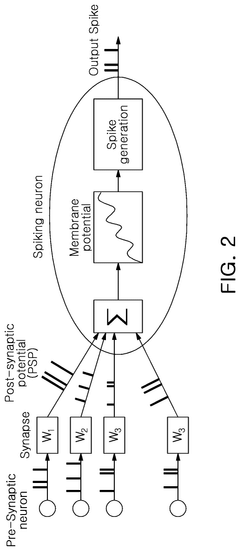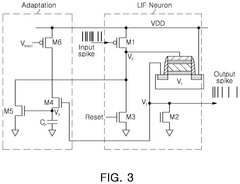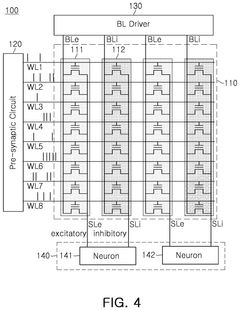How Neuromorphic Materials Address Energy Efficiency Demands
OCT 27, 20259 MIN READ
Generate Your Research Report Instantly with AI Agent
Patsnap Eureka helps you evaluate technical feasibility & market potential.
Neuromorphic Materials Background and Objectives
Neuromorphic computing represents a paradigm shift in computational architecture, drawing inspiration from the structure and function of biological neural systems. This field has evolved significantly since the 1980s when Carver Mead first introduced the concept, proposing hardware implementations that mimic neural processing. The trajectory of neuromorphic computing has been characterized by increasing sophistication in both theoretical frameworks and material implementations, with recent years witnessing accelerated development due to the convergence of advanced materials science, nanotechnology, and artificial intelligence research.
The fundamental premise of neuromorphic computing lies in its departure from traditional von Neumann architecture, which separates memory and processing units. This separation creates a bottleneck that limits computational efficiency and increases energy consumption. In contrast, neuromorphic systems integrate memory and processing functions, similar to biological neural networks, potentially offering orders of magnitude improvements in energy efficiency.
Current technological trends indicate a growing emphasis on developing specialized materials that can inherently perform neuromorphic functions. These materials exhibit properties such as memristive behavior, spike-timing-dependent plasticity, and other characteristics that enable efficient implementation of neural network operations at the hardware level. The evolution of these materials has progressed from simple two-terminal devices to complex multi-functional systems capable of emulating various aspects of biological neural processing.
The primary objective in neuromorphic materials research is to address the critical challenge of energy efficiency in computing systems. With data centers currently consuming approximately 1-2% of global electricity and this figure projected to increase substantially, there is an urgent need for more energy-efficient computing paradigms. Neuromorphic materials aim to enable computing systems that can process information with energy requirements closer to those of the human brain, which operates at approximately 20 watts while performing complex cognitive tasks.
Additional objectives include developing materials that support real-time processing of sensory data, enable on-device learning capabilities, and facilitate edge computing applications where power constraints are particularly stringent. These goals align with broader technological trends toward more distributed, intelligent systems that can process information locally rather than relying on cloud-based resources.
The technical roadmap for neuromorphic materials encompasses several key milestones: first, the refinement of existing memristive materials to improve reliability and manufacturability; second, the development of novel material systems with enhanced neuromorphic properties; and third, the integration of these materials into practical computing architectures that can demonstrate significant energy efficiency advantages in real-world applications.
The fundamental premise of neuromorphic computing lies in its departure from traditional von Neumann architecture, which separates memory and processing units. This separation creates a bottleneck that limits computational efficiency and increases energy consumption. In contrast, neuromorphic systems integrate memory and processing functions, similar to biological neural networks, potentially offering orders of magnitude improvements in energy efficiency.
Current technological trends indicate a growing emphasis on developing specialized materials that can inherently perform neuromorphic functions. These materials exhibit properties such as memristive behavior, spike-timing-dependent plasticity, and other characteristics that enable efficient implementation of neural network operations at the hardware level. The evolution of these materials has progressed from simple two-terminal devices to complex multi-functional systems capable of emulating various aspects of biological neural processing.
The primary objective in neuromorphic materials research is to address the critical challenge of energy efficiency in computing systems. With data centers currently consuming approximately 1-2% of global electricity and this figure projected to increase substantially, there is an urgent need for more energy-efficient computing paradigms. Neuromorphic materials aim to enable computing systems that can process information with energy requirements closer to those of the human brain, which operates at approximately 20 watts while performing complex cognitive tasks.
Additional objectives include developing materials that support real-time processing of sensory data, enable on-device learning capabilities, and facilitate edge computing applications where power constraints are particularly stringent. These goals align with broader technological trends toward more distributed, intelligent systems that can process information locally rather than relying on cloud-based resources.
The technical roadmap for neuromorphic materials encompasses several key milestones: first, the refinement of existing memristive materials to improve reliability and manufacturability; second, the development of novel material systems with enhanced neuromorphic properties; and third, the integration of these materials into practical computing architectures that can demonstrate significant energy efficiency advantages in real-world applications.
Market Analysis for Energy-Efficient Computing Solutions
The global market for energy-efficient computing solutions is experiencing unprecedented growth, driven by the increasing demand for computational power across various sectors while facing constraints of energy consumption and environmental impact. Current market valuations indicate that energy-efficient computing solutions represent a significant segment of the broader computing market, with particularly strong growth in data centers, edge computing, and mobile device sectors.
Data centers remain the largest consumers of computational energy, accounting for approximately 1-2% of global electricity consumption. This has created a substantial market opportunity for neuromorphic materials and other energy-efficient computing technologies that can deliver performance improvements while reducing power requirements. The market for energy-efficient data center solutions alone is expanding at a compound annual growth rate exceeding traditional computing hardware markets.
Edge computing represents another rapidly growing segment, as IoT deployments continue to accelerate across industrial, consumer, and infrastructure applications. The need for local processing with minimal energy footprint has created demand for ultra-efficient computing solutions that can operate with limited power resources. Neuromorphic materials offer particular advantages in this space due to their ability to process sensory data with minimal energy expenditure.
Mobile and portable device manufacturers constitute a third major market segment, continuously seeking technologies that can extend battery life while supporting increasingly complex applications. The premium smartphone market especially values energy efficiency as a differentiating factor, creating opportunities for advanced materials that can deliver performance gains without corresponding increases in power consumption.
Geographic distribution of market demand shows concentration in North America, Europe, and East Asia, with North America leading in terms of investment and adoption. However, emerging markets are showing accelerated growth rates as they build new digital infrastructure with less legacy technology constraints.
Market forecasts suggest that energy-efficient computing solutions will outpace the growth of the overall computing hardware market by a factor of 1.5 to 2 over the next five years. This is supported by regulatory pressures, corporate sustainability commitments, and the economic benefits of reduced operational costs associated with lower energy consumption.
Customer segmentation reveals that hyperscale cloud providers and large enterprises are the early adopters of advanced energy-efficient technologies, willing to invest in solutions that deliver long-term operational savings. Consumer markets tend to follow as technologies mature and costs decrease, with energy efficiency becoming an increasingly important purchasing consideration.
Data centers remain the largest consumers of computational energy, accounting for approximately 1-2% of global electricity consumption. This has created a substantial market opportunity for neuromorphic materials and other energy-efficient computing technologies that can deliver performance improvements while reducing power requirements. The market for energy-efficient data center solutions alone is expanding at a compound annual growth rate exceeding traditional computing hardware markets.
Edge computing represents another rapidly growing segment, as IoT deployments continue to accelerate across industrial, consumer, and infrastructure applications. The need for local processing with minimal energy footprint has created demand for ultra-efficient computing solutions that can operate with limited power resources. Neuromorphic materials offer particular advantages in this space due to their ability to process sensory data with minimal energy expenditure.
Mobile and portable device manufacturers constitute a third major market segment, continuously seeking technologies that can extend battery life while supporting increasingly complex applications. The premium smartphone market especially values energy efficiency as a differentiating factor, creating opportunities for advanced materials that can deliver performance gains without corresponding increases in power consumption.
Geographic distribution of market demand shows concentration in North America, Europe, and East Asia, with North America leading in terms of investment and adoption. However, emerging markets are showing accelerated growth rates as they build new digital infrastructure with less legacy technology constraints.
Market forecasts suggest that energy-efficient computing solutions will outpace the growth of the overall computing hardware market by a factor of 1.5 to 2 over the next five years. This is supported by regulatory pressures, corporate sustainability commitments, and the economic benefits of reduced operational costs associated with lower energy consumption.
Customer segmentation reveals that hyperscale cloud providers and large enterprises are the early adopters of advanced energy-efficient technologies, willing to invest in solutions that deliver long-term operational savings. Consumer markets tend to follow as technologies mature and costs decrease, with energy efficiency becoming an increasingly important purchasing consideration.
Current Neuromorphic Materials Landscape and Barriers
The neuromorphic materials landscape is currently dominated by several key material categories, each with distinct properties and limitations. Memristive materials, including metal oxides like TiO2 and HfO2, represent a significant portion of research focus due to their ability to mimic synaptic behavior through resistance changes. These materials have demonstrated promising results in pattern recognition tasks while consuming orders of magnitude less power than conventional computing architectures.
Phase-change materials (PCMs) such as Ge2Sb2Te5 constitute another important category, offering non-volatile memory capabilities through reversible transitions between amorphous and crystalline states. While PCMs exhibit excellent scalability and switching speed, they face challenges related to high programming currents and thermal management issues that limit their energy efficiency potential.
Ferroelectric materials, particularly hafnium oxide-based compounds, have emerged as promising candidates due to their CMOS compatibility and low switching energy. However, endurance limitations and integration complexities remain significant barriers to widespread implementation in neuromorphic systems.
The landscape also includes emerging two-dimensional materials like graphene and transition metal dichalcogenides, which offer unique electronic properties and potential for ultra-low power operation. These materials remain primarily in the research phase, with substantial gaps between laboratory demonstrations and practical implementation.
A critical barrier across all material platforms is the challenge of achieving reliable, reproducible performance at scale. Device-to-device and cycle-to-cycle variations significantly impact the predictability of neuromorphic systems, particularly for applications requiring precise weight updates and storage. This variability necessitates complex compensation schemes that partially negate energy efficiency gains.
Integration with conventional CMOS technology presents another substantial hurdle. While some materials (particularly certain metal oxides) offer reasonable compatibility, others require specialized fabrication processes that complicate manufacturing and increase costs. The lack of standardized fabrication protocols further impedes commercial development.
Energy efficiency barriers persist even in promising materials, with most current implementations still requiring significantly more energy per operation than biological neural systems. Leakage currents, parasitic capacitances, and switching energy overheads remain problematic, particularly for edge computing applications with strict power constraints.
The fragmented research landscape presents additional challenges, with competing material platforms and architectures making it difficult to establish industry standards. This fragmentation slows progress toward practical applications and delays the development of design tools and methodologies necessary for widespread adoption of neuromorphic computing solutions.
Phase-change materials (PCMs) such as Ge2Sb2Te5 constitute another important category, offering non-volatile memory capabilities through reversible transitions between amorphous and crystalline states. While PCMs exhibit excellent scalability and switching speed, they face challenges related to high programming currents and thermal management issues that limit their energy efficiency potential.
Ferroelectric materials, particularly hafnium oxide-based compounds, have emerged as promising candidates due to their CMOS compatibility and low switching energy. However, endurance limitations and integration complexities remain significant barriers to widespread implementation in neuromorphic systems.
The landscape also includes emerging two-dimensional materials like graphene and transition metal dichalcogenides, which offer unique electronic properties and potential for ultra-low power operation. These materials remain primarily in the research phase, with substantial gaps between laboratory demonstrations and practical implementation.
A critical barrier across all material platforms is the challenge of achieving reliable, reproducible performance at scale. Device-to-device and cycle-to-cycle variations significantly impact the predictability of neuromorphic systems, particularly for applications requiring precise weight updates and storage. This variability necessitates complex compensation schemes that partially negate energy efficiency gains.
Integration with conventional CMOS technology presents another substantial hurdle. While some materials (particularly certain metal oxides) offer reasonable compatibility, others require specialized fabrication processes that complicate manufacturing and increase costs. The lack of standardized fabrication protocols further impedes commercial development.
Energy efficiency barriers persist even in promising materials, with most current implementations still requiring significantly more energy per operation than biological neural systems. Leakage currents, parasitic capacitances, and switching energy overheads remain problematic, particularly for edge computing applications with strict power constraints.
The fragmented research landscape presents additional challenges, with competing material platforms and architectures making it difficult to establish industry standards. This fragmentation slows progress toward practical applications and delays the development of design tools and methodologies necessary for widespread adoption of neuromorphic computing solutions.
Contemporary Neuromorphic Material Solutions
01 Memristive materials for energy-efficient neuromorphic computing
Memristive materials are being developed for neuromorphic computing applications due to their ability to mimic synaptic behavior while consuming minimal power. These materials can change their resistance based on the history of applied voltage or current, enabling efficient implementation of neural network functions. The integration of these materials into neuromorphic architectures significantly reduces energy consumption compared to traditional computing approaches, making them ideal for edge computing and IoT applications.- Memristive materials for energy-efficient neuromorphic computing: Memristive materials are being developed for neuromorphic computing applications due to their ability to mimic synaptic functions with high energy efficiency. These materials can change their resistance states based on the history of applied voltage or current, enabling them to store and process information simultaneously. This approach significantly reduces energy consumption compared to traditional computing architectures by eliminating the need for separate memory and processing units.
- Phase-change materials for low-power neuromorphic devices: Phase-change materials offer promising solutions for energy-efficient neuromorphic computing by utilizing their ability to rapidly switch between amorphous and crystalline states. These materials can implement synaptic plasticity with minimal energy requirements, allowing for the development of ultra-low power neuromorphic systems. The non-volatile nature of these materials also eliminates standby power consumption, further enhancing overall energy efficiency in neural network implementations.
- 2D materials for energy-efficient neuromorphic architectures: Two-dimensional materials such as graphene, transition metal dichalcogenides, and hexagonal boron nitride are being explored for neuromorphic applications due to their unique electronic properties and atomic-scale thickness. These materials enable the development of highly scalable and energy-efficient neuromorphic devices with reduced leakage currents and lower operating voltages. Their excellent carrier mobility and tunable bandgaps make them particularly suitable for implementing energy-efficient synaptic functions in neuromorphic systems.
- Ferroelectric materials for ultra-low power neuromorphic computing: Ferroelectric materials are being utilized in neuromorphic computing to achieve ultra-low power consumption through their non-volatile polarization states. These materials can maintain their state without continuous power supply and can be switched with minimal energy input. The implementation of ferroelectric-based synaptic devices allows for significant reduction in energy consumption while maintaining high performance in neural network operations, making them ideal candidates for energy-efficient neuromorphic systems.
- Organic and bio-inspired materials for sustainable neuromorphic systems: Organic and bio-inspired materials are emerging as sustainable alternatives for neuromorphic computing applications. These materials can operate at ultra-low voltages and power levels, mimicking the energy efficiency of biological neural systems. Their flexibility, biocompatibility, and potential for biodegradability offer additional advantages for sustainable computing solutions. By emulating the parallel processing and adaptive learning capabilities of biological systems, these materials enable the development of highly energy-efficient neuromorphic architectures.
02 Phase-change materials for low-power neuromorphic systems
Phase-change materials offer unique properties that enable energy-efficient neuromorphic computing by utilizing their ability to rapidly switch between amorphous and crystalline states. These materials can store multiple resistance states in a single cell, allowing for analog-like computation with minimal energy requirements. Their non-volatile nature eliminates static power consumption, and their scalability makes them suitable for high-density neuromorphic architectures that can perform complex cognitive tasks with significantly reduced power consumption.Expand Specific Solutions03 2D materials for ultra-low power neuromorphic devices
Two-dimensional materials such as graphene, transition metal dichalcogenides, and hexagonal boron nitride are being explored for neuromorphic applications due to their exceptional electronic properties and atomic-scale thickness. These materials enable the creation of ultra-thin, flexible neuromorphic devices with extremely low switching energies. Their unique band structures and tunable electronic properties allow for the implementation of synaptic functions with minimal energy dissipation, making them promising candidates for next-generation, energy-efficient neuromorphic systems.Expand Specific Solutions04 Ferroelectric materials for energy-efficient neuromorphic computing
Ferroelectric materials are being utilized in neuromorphic computing due to their non-volatile polarization states that can be switched with very low energy. These materials can implement synaptic weight changes through polarization switching, enabling efficient learning algorithms. The inherently low switching energy of ferroelectric domains, combined with their high endurance and retention, makes them ideal for implementing energy-efficient neuromorphic architectures that can perform both computation and memory functions in the same physical location.Expand Specific Solutions05 Spintronic materials for ultra-efficient neuromorphic hardware
Spintronic materials leverage electron spin rather than charge for information processing, offering a pathway to extremely energy-efficient neuromorphic computing. These materials enable magnetic tunnel junctions and domain wall devices that can implement synaptic and neuronal functions with energy consumption orders of magnitude lower than conventional CMOS approaches. The non-volatile nature of spin states eliminates standby power, while the fast switching dynamics allow for high-speed operation, making spintronic materials particularly promising for large-scale, energy-efficient neuromorphic systems.Expand Specific Solutions
Leading Organizations in Neuromorphic Materials Research
Neuromorphic materials technology is currently in an early growth phase, with the market expected to expand significantly as energy efficiency becomes a critical concern in computing. The global market for neuromorphic computing is projected to reach several billion dollars by 2030, driven by applications in AI, IoT, and edge computing. Leading players like IBM, Intel, and Samsung are advancing hardware implementations, while research institutions such as MIT, Peking University, and KAIST are developing fundamental materials science. Companies like Syntiant and SK hynix are focusing on specialized neuromorphic chips for specific applications. The technology is approaching commercial viability, with early adopters implementing neuromorphic solutions in limited domains, though widespread adoption requires further advances in materials science and manufacturing processes.
Samsung Electronics Co., Ltd.
Technical Solution: Samsung has developed neuromorphic computing solutions based on their expertise in memory technologies, particularly focusing on resistive RAM (ReRAM) and magnetoresistive RAM (MRAM) as energy-efficient neuromorphic materials. Their approach integrates these novel memory elements directly into processing architectures to create brain-inspired computing systems. Samsung's neuromorphic chips utilize crossbar arrays of memristive devices that can simultaneously store and process information, eliminating the energy-intensive data transfer between separate memory and processing units[1]. Their research demonstrates that these neuromorphic materials can reduce energy consumption by up to 100x compared to conventional CMOS-based neural network implementations. Samsung has also pioneered 3D stacking of neuromorphic elements, achieving unprecedented integration density while maintaining energy efficiency[2]. In collaboration with research institutions, Samsung has developed phase-change memory (PCM) based synaptic devices that can implement spike-timing-dependent plasticity with energy consumption as low as 1.8 pJ per synaptic event, approaching the efficiency of biological synapses (which operate at approximately 1-10 fJ)[3]. Their neuromorphic vision sensors use event-based processing that only consumes energy when detecting changes in the visual field.
Strengths: Vertical integration capabilities (from materials to systems); extensive manufacturing expertise in memory technologies; ability to leverage existing semiconductor fabrication infrastructure; strong IP portfolio in neuromorphic materials. Weaknesses: Still primarily in research phase for neuromorphic computing; faces challenges in standardization and software ecosystem development; competition from specialized neuromorphic startups; balancing reliability and performance trade-offs in novel materials.
International Business Machines Corp.
Technical Solution: IBM has pioneered neuromorphic computing through its TrueNorth and subsequent neuromorphic chips. Their approach focuses on mimicking the brain's neural architecture using specialized hardware that integrates memory and processing. IBM's neuromorphic materials include phase-change memory (PCM) elements that function as artificial synapses, capable of gradual resistance changes similar to biological synaptic plasticity[1]. Their SyNAPSE (Systems of Neuromorphic Adaptive Plastic Scalable Electronics) program developed chips with over 1 million neurons and 256 million synapses while consuming only 70mW of power - achieving energy efficiency approximately 1000 times better than conventional processors for certain cognitive tasks[2]. IBM has also developed magnetic tunnel junction (MTJ) devices that can implement stochastic neural networks, further reducing energy consumption by leveraging inherent material properties rather than complex digital circuitry[3].
Strengths: Extremely low power consumption (70mW for 1 million neurons); high integration density; hardware-accelerated learning capabilities; mature fabrication techniques compatible with existing semiconductor processes. Weaknesses: Limited flexibility compared to general-purpose processors; challenges in programming paradigms; requires specialized software development; potential reliability issues with novel materials under long-term operation.
Critical Neuromorphic Material Technologies Analysis
Neuromorphic device based on memristor device, and neuromorphic system using same
PatentWO2023027492A1
Innovation
- A neuromorphic device using a memristor with a switching layer of amorphous germanium sulfide and a source layer of copper telluride, allowing for both artificial neuron and synapse characteristics to be implemented, with a crossbar-type structure that adjusts current density for volatility or non-volatility, enabling efficient memory operations and paired pulse facilitation.
Neuromorphic computing device using spiking neural network and operating method thereof
PatentPendingUS20250292072A1
Innovation
- A neuromorphic computing device utilizing ferroelectric transistors and synapse arrays with excitatory and inhibitory synapses, enabling 3D stacking and flexible neuron settings through adjustable firing rates, achieved by controlling power supply voltages and gate voltages.
Sustainability Impact of Neuromorphic Computing
Neuromorphic computing represents a paradigm shift in sustainable technology, offering unprecedented energy efficiency compared to conventional computing architectures. The environmental impact of this technology extends far beyond simple power consumption metrics, creating a multi-faceted sustainability profile that deserves careful examination.
The primary sustainability advantage of neuromorphic systems stems from their brain-inspired design, which fundamentally changes the energy equation in computing. While traditional von Neumann architectures consume significant power shuttling data between memory and processing units, neuromorphic systems integrate these functions, dramatically reducing energy requirements. Quantitative assessments indicate that neuromorphic chips can achieve computational tasks with energy savings of 100-1000x compared to conventional processors for certain workloads, particularly those involving pattern recognition and sensory processing.
Carbon footprint reduction represents another critical sustainability dimension. Data centers currently account for approximately 1% of global electricity consumption, with projections showing alarming growth trajectories. Neuromorphic computing offers a potential solution by enabling edge computing implementations that process data locally, reducing the need for cloud transmission and storage. This distributed approach could significantly decrease infrastructure requirements and associated carbon emissions across the technology ecosystem.
Material sustainability considerations also favor neuromorphic approaches. Many neuromorphic materials utilize abundant elements rather than rare earth metals that dominate conventional semiconductor manufacturing. Additionally, the simplified architecture of some neuromorphic designs requires fewer fabrication steps and potentially less toxic processing chemicals. This materials advantage extends to end-of-life considerations, where simpler component structures may facilitate more effective recycling pathways.
The water footprint of computing represents an often-overlooked sustainability factor. Traditional semiconductor manufacturing requires enormous quantities of ultra-pure water—up to thousands of liters per wafer. Early research suggests that certain neuromorphic materials and manufacturing approaches could substantially reduce water requirements, though comprehensive lifecycle analyses are still emerging in this rapidly evolving field.
Beyond direct environmental impacts, neuromorphic computing enables new categories of sustainable applications. These include ultra-efficient environmental monitoring systems, smart infrastructure optimization, and precision resource management tools that would be impractical with conventional computing approaches due to power constraints. This application-level sustainability impact may ultimately prove more significant than the direct energy savings of the technology itself.
The primary sustainability advantage of neuromorphic systems stems from their brain-inspired design, which fundamentally changes the energy equation in computing. While traditional von Neumann architectures consume significant power shuttling data between memory and processing units, neuromorphic systems integrate these functions, dramatically reducing energy requirements. Quantitative assessments indicate that neuromorphic chips can achieve computational tasks with energy savings of 100-1000x compared to conventional processors for certain workloads, particularly those involving pattern recognition and sensory processing.
Carbon footprint reduction represents another critical sustainability dimension. Data centers currently account for approximately 1% of global electricity consumption, with projections showing alarming growth trajectories. Neuromorphic computing offers a potential solution by enabling edge computing implementations that process data locally, reducing the need for cloud transmission and storage. This distributed approach could significantly decrease infrastructure requirements and associated carbon emissions across the technology ecosystem.
Material sustainability considerations also favor neuromorphic approaches. Many neuromorphic materials utilize abundant elements rather than rare earth metals that dominate conventional semiconductor manufacturing. Additionally, the simplified architecture of some neuromorphic designs requires fewer fabrication steps and potentially less toxic processing chemicals. This materials advantage extends to end-of-life considerations, where simpler component structures may facilitate more effective recycling pathways.
The water footprint of computing represents an often-overlooked sustainability factor. Traditional semiconductor manufacturing requires enormous quantities of ultra-pure water—up to thousands of liters per wafer. Early research suggests that certain neuromorphic materials and manufacturing approaches could substantially reduce water requirements, though comprehensive lifecycle analyses are still emerging in this rapidly evolving field.
Beyond direct environmental impacts, neuromorphic computing enables new categories of sustainable applications. These include ultra-efficient environmental monitoring systems, smart infrastructure optimization, and precision resource management tools that would be impractical with conventional computing approaches due to power constraints. This application-level sustainability impact may ultimately prove more significant than the direct energy savings of the technology itself.
Manufacturing Scalability Challenges
The scaling of neuromorphic materials from laboratory prototypes to commercial production represents one of the most significant challenges in the advancement of energy-efficient computing technologies. Current manufacturing processes for conventional semiconductors are highly optimized for CMOS technology, but neuromorphic materials often require fundamentally different fabrication approaches. The integration of novel materials such as phase-change memory, memristors, and spintronic devices into existing semiconductor fabrication lines presents considerable technical hurdles.
Material consistency poses a particular challenge, as neuromorphic computing relies on precise analog behaviors that can be compromised by minor variations in material composition. The manufacturing yield of these materials must achieve consistency across billions of components on a single chip, a requirement that current processes struggle to meet. For example, hafnium oxide-based memristors exhibit switching variability that can significantly impact neural network performance when scaled to large arrays.
Dimensional scaling presents another critical barrier. While conventional transistors have benefited from decades of miniaturization following Moore's Law, many neuromorphic materials face fundamental physical limitations at nanoscale dimensions. The ionic mechanisms underlying resistive switching in oxide-based memristors, for instance, become increasingly stochastic at dimensions below 10nm, compromising reliability and predictability.
Integration with CMOS technology represents a third major challenge. Most practical neuromorphic systems require hybrid architectures that combine novel materials with conventional CMOS for control circuitry. This necessitates process compatibility between disparate material systems, often with conflicting thermal budgets and chemical sensitivities. The back-end-of-line (BEOL) integration of memristive devices, for example, must occur at temperatures below 400°C to avoid damaging underlying CMOS layers.
Cost-effective production methods remain elusive for many neuromorphic materials. While academic demonstrations have shown promising energy efficiency metrics, translating these into economically viable manufacturing processes requires significant investment. The specialized deposition techniques needed for many phase-change materials and complex oxides are currently not optimized for high-volume production, resulting in prohibitive costs per device.
Equipment standardization also lags behind conventional semiconductor manufacturing. The specialized tools required for precise deposition and characterization of neuromorphic materials are often custom-built for research purposes and lack the reliability and throughput needed for industrial-scale production. This equipment gap creates a significant barrier to commercialization, as capital expenditure for specialized fabrication lines represents a major investment risk.
Material consistency poses a particular challenge, as neuromorphic computing relies on precise analog behaviors that can be compromised by minor variations in material composition. The manufacturing yield of these materials must achieve consistency across billions of components on a single chip, a requirement that current processes struggle to meet. For example, hafnium oxide-based memristors exhibit switching variability that can significantly impact neural network performance when scaled to large arrays.
Dimensional scaling presents another critical barrier. While conventional transistors have benefited from decades of miniaturization following Moore's Law, many neuromorphic materials face fundamental physical limitations at nanoscale dimensions. The ionic mechanisms underlying resistive switching in oxide-based memristors, for instance, become increasingly stochastic at dimensions below 10nm, compromising reliability and predictability.
Integration with CMOS technology represents a third major challenge. Most practical neuromorphic systems require hybrid architectures that combine novel materials with conventional CMOS for control circuitry. This necessitates process compatibility between disparate material systems, often with conflicting thermal budgets and chemical sensitivities. The back-end-of-line (BEOL) integration of memristive devices, for example, must occur at temperatures below 400°C to avoid damaging underlying CMOS layers.
Cost-effective production methods remain elusive for many neuromorphic materials. While academic demonstrations have shown promising energy efficiency metrics, translating these into economically viable manufacturing processes requires significant investment. The specialized deposition techniques needed for many phase-change materials and complex oxides are currently not optimized for high-volume production, resulting in prohibitive costs per device.
Equipment standardization also lags behind conventional semiconductor manufacturing. The specialized tools required for precise deposition and characterization of neuromorphic materials are often custom-built for research purposes and lack the reliability and throughput needed for industrial-scale production. This equipment gap creates a significant barrier to commercialization, as capital expenditure for specialized fabrication lines represents a major investment risk.
Unlock deeper insights with Patsnap Eureka Quick Research — get a full tech report to explore trends and direct your research. Try now!
Generate Your Research Report Instantly with AI Agent
Supercharge your innovation with Patsnap Eureka AI Agent Platform!


